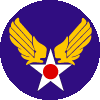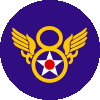 GO TO... KEEP 'EM FLYING |
|
|
||||||
|
BackgroundThe Crush Cap is a storied article of WWII Army Air Corps gear. Nothing made an aviator look more seasoned than when sporting a floppy, crumpled cap riding at a jaunty angle atop his head.The Visor Cap, or Service Cap, is essentially the primary dress headgear of servicemen and it bears, in the case of the Army and Army Air Corps, the insignia of the coat of arms of the United States. As such, the service cap is a crisply angled cap with stiff support to maintain its respectable posture. Army Air Corps personnel, while wearing the visor cap in flight, took to removing the stiffening in order to comfortably wear a communications headset over the cap. In time, the cap would become crushed and softened. A cap which had seen a lot of action eventually came to be known as a "50 mission crush cap," and the wearer of such a cap came to be recognized as an experienced veteran. In deference to the air service the Officer's Guide states, "Officers of the Army Air Forces wear a similar cap [to officers of the Army] except that the front spring stiffening may be omitted and the grommet may be removed." The front spring stiffening is what supports the insignia and also keeps the front of the cap jutting strongly upward and forward. This can vary from a curled piece of wire spring to a solid metal plate. The grommet is a round support, often simply a stiff piece of metal wire, that keeps the top of the cap round and suspended. While the grommet can be readily extracted from the cap, the front spring stiffening is typically sewn integrally into the cap and is not easily removed. Eventually, manufacturers began to make caps specifically for aviators. These caps were specially made to be soft and crushable with a thinner and more flexible leather visor, little or no front spring stiffening, and a softer headband. While there was some variation in crushability between the different models, some of these caps could be very easily rolled up and stuffed into a pocket.
ObservationsStandard service caps are found to be constructed of several types of material. For the winter uniform there are the olive drab (O.D.) shades and these are usually either of a felt type of material or of the darker shade wool elastique. For wear with the summer uniform, caps were a tan khaki shade of either cotton, rayon, cotton/mohair blend, or worsted wool.True crush caps are most commonly found in the O.D. shade and seem to be exclusively of elastique material, presumably since the elastique is lighter and more supple than the felt. Crush caps in khaki shades appear to be primarily of the wool worsted material but, due to the limited numbers of these around, this observation may not be accurate. While most crush caps were made for officers, there are examples of both O.D. and khaki enlisted men's (E.M.) crush caps. These seem to have been in much more limited quantity compared to the officer's crush caps. Many service caps these days are pitched to collectors as having a crushed look. As has been described here, however, not all crushed caps are crush caps. In the collector's market, the true crush caps are more highly prized and carry higher market values. While there are a few sources for reproduction crush caps, only one which has recently come to my attention truly lives up to the quality and character of the originals, the Diamond Cap Co. For a link to Diamond and some other sources, see Section 1.5 of the Previously Asked Questions Page.
ExamplesBelow are several examples of crush caps and standard visor caps.
Probably the best known and apparently most widely used crush cap was the Flighter by Bancroft. The visor on the Flighter model has a rather distinctive dome shape and had, as claimed on the Flighter logo, "curve control." Possibly the best quality caps were those produced by Luxenberg, a highly regarded maker of military clothing and also insignia. Luxenberg items are prized by collectors.
The two major differences between the officers' and enlisted mens' caps are the insignia format and the decorative band sewn to the outside of the headband on the officers' version.
Copyright © 1997-2008 Marc D. Weinshenker. All rights reserved. |




